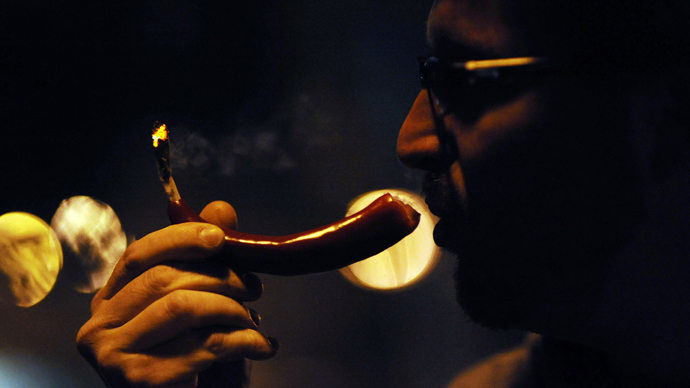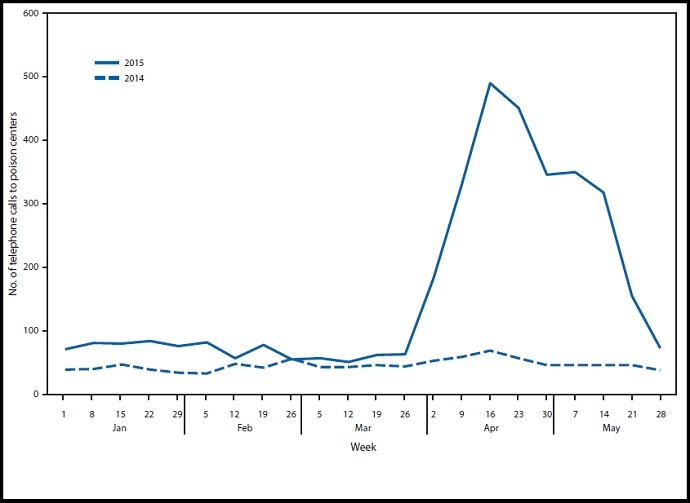Reports of synthetic marijuana poisoning up 229% in 2015

Spice, K2 and other synthetic cannabinoids are marketed as safe, legal alternatives to marijuana, but calls to US poison control centers about users of the chemical products skyrocketed in the first few months of 2015, according to the US government.
Monthly calls related to the adverse effects of synthetic marijuana jumped 330 percent between January and April, the Centers for Disease Control and Prevention (CDC) said on Friday. The number of those calls to poison control centers between January and May was also a 229 percent increase over the same time period in 2014, from 1,085 calls to 3,572.

The increased calls due to adverse reactions included 15 deaths between January and May 2015, three times higher than those same months in 2014. In January, a US soldier who was self-monitoring for Ebola died near Fort Hood, Texas. It turned out that his death was due to “synthetic cannabinoid intoxication” from Spice, his autopsy found.
READ MORE: Spice, not Ebola, kills Ft. Hood soldier
The most commonly reported adverse health effects were agitation at 35.3 percent of calls, tachycardia (29 percent), drowsiness or lethargy (26.3 percent), vomiting (16.4 percent) and confusion (4.2 percent). When medical outcomes were reported for the calls, 335 ‒ or 11.3 percent ‒ had a major adverse effect, meaning signs or symptoms that are life-threatening or result in substantial residual disability or disfigurement. Almost half of callers ‒ 47.5 percent ‒ had moderate effect, while 37 percent had a minor effect, meaning minimally bothersome.
Synthetic cannabinoids are known by a variety of names, such as synthetic marijuana, spice, K2, black mamba and crazy clown, and can be sold legally as herbal products. They are made of various psychoactive chemicals that are sprayed onto plant material, which is then often smoked or ingested to achieve a "high" similar to that of regular marijuana.
Poison centers had more than 3,500 calls on synthetic cannabinoid use Jan-May 2015; 229% increase over 2014 period. http://t.co/72Uc5ddQIq
— Dr. Tom Frieden (@DrFriedenCDC) June 12, 2015
“The increasing number of synthetic cannabinoid variants available, higher toxicity of new variants, and the potentially increased use as indicated by calls to poison centers might suggest that synthetic cannabinoids pose an emerging public health threat,” CDC epidemiologist Royal Law wrote in the agency’s Morbidity and Mortality Weekly Report, which analyzed data tracked by the National Poison Data System.
“Multiple other recent outbreaks suggest a need for greater public health surveillance and awareness, targeted public health messaging, and enhanced efforts to remove these products from the market,” Law added.
The Drug Enforcement Agency designated the five active chemicals found in Spice and other such synthetic products as Schedule I controlled substances, making it illegal to sell, buy or possess them.
The problem with regulating or banning the products is that the producers of synthetic marijuana products are continually tweaking their formulas. The herbal mixtures themselves are legal, albeit labeled as “not for human consumption.”

“Manufacturers of Spice products attempt to evade these legal restrictions by substituting different chemicals in their mixtures, while the DEA continues to monitor the situation and evaluate the need for updating the list of banned cannabinoids,” the National Institute on Drug Abuse (NIDA) says in its drug facts on synthetic marijuana.
In 2012, synthetic cannabinoids were the second-most popular drug among high-school seniors, behind only marijuana itself, according to NIDA.
“Easy access and the misperception that Spice products are ‘natural’ and therefore harmless have likely contributed to their popularity,” the institute noted. “Another selling point is that the chemicals used in Spice are not easily detected in standard drug tests.”
The median age of the phone calls to poison control centers, however, was 26. Age was not recorded in all the phone calls, but was reported nearly 95 percent of the time.












